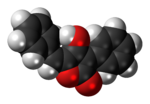
| |||
| |||
| Names | |||
|---|---|---|---|
| IUPAC name
(E/Z)-5-Phenylmethylene-4-hydroxy-3-phenylfuran-2(5H)-one
| |||
| Identifiers | |||
| |||
3D model (JSmol)
|
| ||
| ChemSpider |
| ||
PubChem CID
|
|||
| UNII | |||
| |||
| |||
| Properties | |||
| C17H12O3 | |||
| Molar mass | 264.280 g·mol−1 | ||
| Appearance | Yellow needles | ||
| Melting point | 243 to 247 °C (469 to 477 °F; 516 to 520 K)[1] | ||
| Insoluble | |||
| Related compounds | |||
Related compounds
|
Pulvinic acid, Vulpinic acid | ||
Except where otherwise noted, data are given for materials in their standard state (at 25 °C [77 °F], 100 kPa).
| |||
Pulvinone, an organic compound belonging to the esters, lactones, alcohols and butenolides classes, is a yellow crystalline solid. Although the pulvinone is not a natural product, several naturally occurring hydroxylated derivatives are known. These hydroxylated pulvinones are produced by fungal species, such as the in Europe common Larch Bolete (Boletus elegans, also known as Suillus grevillei), or by moulds such as Aspergillus terreus.
- ^ Ramage, Robert; Griffiths, Gareth J.; Shutt, Fiona E.; Sweeney, John N. A. (1984). "Dioxolanones as synthetic intermediates. Part 2. Synthesis of tetronic acids and pulvinones". Journal of the Chemical Society, Perkin Transactions 1: 1539. doi:10.1039/P19840001539.

